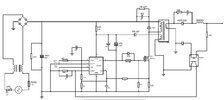i made 220V AC to 12V DC 5A SMPS based on UC3842 using forward converter. schematic attached. supply's output voltage is ok and on no load (except indication led) pwm duty cycle is 1.1% with no mosfet heating (IRF740), but when loaded with even a little load of < 500mA, mosfet heats up although the primary side current is very less (<150mA) while the IRF740 is rated for 10A current. is it the snubber problem ? i first used 50K snubber resistance based on a design i found on the web and capacitance of 1nF (RCD snubber) later replaced 50k with 5K. but using less snubber resistance is burning the UC3842 chip, current sense resistance of 0.22R and 1K resistor on current sense line going to pin 3. what am i missing in this design? is it because i am directly driving mosfet from uc3842 output? or is it really the snubber problem. (F sw = 80kHz)


